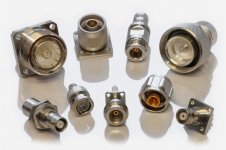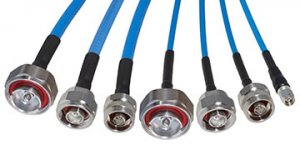Electronic currents are comprised of FINITE numbers of electrons...
There is only the one...
😉
There you are Jan, confirmation you are deaf, don't get too stressed now.
Well, that surely does make life much simpler for me! A lot less stress!

Ella's absolute beauty perfect FM vibrato has also a AM (amplitude modulation).
Do you have any live samples from Pussy Riot (my favorite Russian female band)?
Presume you mean poorly recorded
No,
Bad music
Much like mp3 on your phone sounds normal nearly no matter the bitrate. Put that same file on a nice system and you'll experience all the shortcomings in their clearest representation
The answer could have been known by, as I suggested, listening to DRM (Digital Radio Mondial) on shortwave. For trained ears it would have been audible immediately that the encoders eliminate a lot of the sound below a level that trained ears expect to be present. That makes one sick (not in the meaning of diseased but "bad mood").
I once heard a DRM demonstration and indeed it sounded like crap. AM radio sounds a lot better to me, despite the obvious bandwidth limitations and poor signal-to-noise ratio.
That said, I think a subband coder as used for DRM is a lot worse than a PCM system with decent wordlength and sample rate.
I once heard a DRM demonstration and indeed it sounded like crap. AM radio sounds a lot better to me, despite the obvious bandwidth limitations and poor signal-to-noise ratio.
That said, I think a subband coder as used for DRM is a lot worse than a PCM system with decent wordlength and sample rate.
Indeed. I'm familiar with "quality" AM since the early 1970's and although low power stations were legally required to limit side bands to 10 KHz, many stations didn't use any filtering at all. A receiver with wide-enough IF filter and synchronous demodulation could provide reception comparable with FM before that was mutilated by an LPF at 15 KHz, required for MPX stereo.
No,
Bad music
Much like mp3 on your phone sounds normal nearly no matter the bitrate. Put that same file on a nice system and you'll experience all the shortcomings in their clearest representation
I would expect even a highly compressed file to sound better on a good system than a phone
OK, but can you see how such a vague, broad statement doesn't help to advance the discussion at all?
No.Do you have any live samples from Pussy Riot (my favorite Russian female band)?
I can confirm this.Indeed. I'm familiar with "quality" AM since the early 1970's and although low power stations were legally required to limit side bands to 10 KHz, many stations didn't use any filtering at all. A receiver with wide-enough IF filter and synchronous demodulation could provide reception comparable with FM before that was mutilated by an LPF at 15 KHz, required for MPX stereo.
Sometimes the AM sound was really great. During my post-graduate course after University (1989-1992) I had a tube AM radioreceiver "Belarus-50" (means 1950 year, a gift from a friend). It had so full rich extended bass... Sound was of so high quality and had so really jaw-dropping effect to my frends that I went to the library for schematic to figure out the cause of that and to find out what wrong with rest AM/FM receviers on planet Earth.
The first obvious exotic feature was the speaker without magnet. It had DC-biased speaker with dedicated separate coil - to provide electromagnetic induction effect (this is a special note for "Ph.D. holders" on this forum).
I knew that the real middle of music spectra power is 400-500 Hz and the quality of bass is oftern undervalued by modern radio-engineers.
Now I understand the second and third etc. causes - low count of stages (lower IMD), thick wires (lower skin-effect), low AC current in tube circuits (comparing to transistor) thus again - low skin-effect distortions, thick capacitors and resistors leads.
I am totally free of that modern vintage radio- and audio- idolatry here and there, but here the link for exterior and interior.
Радиоприемник "Беларусь-50"
Update: If you take a look at the best old vintage mixing consoles You will see the same cause of good sound: THICK WIRES, thick leads of resistors and capacitors, large resistors and capacitors, thus the great ability to conduct signals with high gradient (high slew rate) in passive circuitry.
Abbey Road Studio's REDD console:
The Abbey Road REDD .37 Console Comes To Vintage King - Vintage King Blog
Last edited:
What an insight! To increase your amp's slew rate, just use thicker wires or bigger capacitors! That is priceless!
Jan
Jan
Nope. It has very pre-defined price.What an insight! To increase your amp's slew rate, just use thicker wires or bigger capacitors! That is priceless!
Jan
Sir, have You ever heard that RF connectors have simetimes absolutely enormous sizes?
Even for powers like 20W?
The higher the frequency (slew rate, gradient) the bigger the connectors (that was usually, but recently they use very tricky materials to reduce sizes).


I know! That is why some high power amplifiers have enormous speaker connectors on the back. That is to increase slew rate!
Jan
Jan
Give us some OTHER reason, please. With scientific foundations, please.I know! That is why some high power amplifiers have enormous speaker connectors on the back. That is to increase slew rate!
Jan
But seriously, I think we have a miscommunication here. What is your definition of slew rate?
Jan
Jan
Give us some OTHER reason, please. With scientific foundations, please.
Well, you did! You said: The higher the frequency (slew rate, gradient) the bigger the connectors .
Jan
Nope. It has very pre-defined price.
Sir, have You ever heard that RF connectors have simetimes absolutely enormous sizes?
Even for powers like 20W?
The higher the frequency (slew rate, gradient) the bigger the connectors (that was usually, but recently they use very tricky materials to reduce sizes).
Yet a humble SMA connector can handle 150W at 12 GHz. The filters we used in cellular base stations.had SMA in and N or 7/16 out. 7/16 are very good for terminating 2" heliax but often more pain than they are worth as very sensitive to torque. Torque them wrong and IMD goes through the roof.
No. Thick wires have the same skin effect as somewhat thinner wires. Really thin wires have less skin effect, which is the opposite of what you say.Alex Ra said:thick wires (lower skin-effect)
So the wires in transistor amps are too thin to handle the music signal? You are very good at engineering comedy; have you ever thought of going on stage?low AC current in tube circuits (comparing to transistor) thus again - low skin-effect distortions, thick capacitors and resistors leads.
At first I thought you merely had some idiosyncratic views and a little confusion; now I realise that the basics of electronics escape you.Sir, have You ever heard that RF connectors have simetimes absolutely enormous sizes?
Even for powers like 20W?
The higher the frequency (slew rate, gradient) the bigger the connectors (that was usually, but recently they use very tricky materials to reduce sizes).
- Home
- General Interest
- Everything Else
- Digitalized music causing stress??
